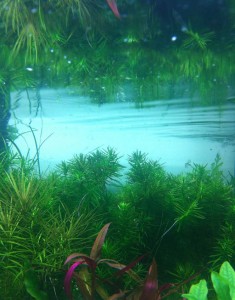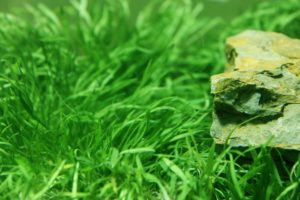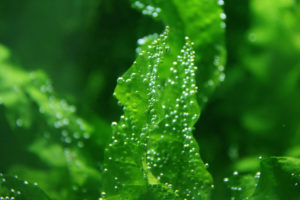 Live Aquatic Plants bring a strong natural feel to an aquarium, mimicking nature in their own way. A planted tank is like having a mini garden in your home. It is very pleasing experience once you attain the setup you desire. There are varying degrees of these and deciding from the start what you are trying to achieve, will take the headache out of changing this later down the track. All planted setups will require a good light and depending on what type of plants you keep, must have the intensity to fulfill the aquarium plants you have picked. I won’t go into detail here about lighting, but your lights need to be strong enough to create the photosynthesis which is required for lush vibrant growth. When setting up a planted tank there can be a tendency to want the plants to grow faster than they are able to. There is only so much nutrients a plant can absorb. By letting your live aquatic plants grow at their optimum rate then a good balance will be established in the aquarium.
Live Aquatic Plants bring a strong natural feel to an aquarium, mimicking nature in their own way. A planted tank is like having a mini garden in your home. It is very pleasing experience once you attain the setup you desire. There are varying degrees of these and deciding from the start what you are trying to achieve, will take the headache out of changing this later down the track. All planted setups will require a good light and depending on what type of plants you keep, must have the intensity to fulfill the aquarium plants you have picked. I won’t go into detail here about lighting, but your lights need to be strong enough to create the photosynthesis which is required for lush vibrant growth. When setting up a planted tank there can be a tendency to want the plants to grow faster than they are able to. There is only so much nutrients a plant can absorb. By letting your live aquatic plants grow at their optimum rate then a good balance will be established in the aquarium.
Nutrients for Live Aquatic Plants
The right nutrients are essential. For a lot of plants, you will be able to get away with just adding an Iron/Potassium liquid supplement. This is adequate enough as your fish & food waste provide other nutrients. Some plants no matter how many fish you have will require micro nutrients that do not come from fish or food waste. If you have a heavily planted tank with small fish then the waste produced from them may not be enough for the plants. This is a good time to add more macro fertilizer to the aquarium. The instructions on a bottle of fertilizer are averages only and if you have a heavily planted tank then you may need to add more.
PH & GH
PH and Hardness play a role in the development of your plants. For pH some plants like more acidic conditions and some like more alkaline. The same goes for hardness. Some like soft water and some like hard water. When choosing your live aquatic plants you can easily fill a tank with an array of different species as most will be able to handle a variable of these conditions.
Carpeted Floor
 A carpeted floor of plants is probably one of the most defining features of aquascaping. This is tremendously popular and a lot of people starting up with a planted aquarium aim to end up with this in their final design. A carpeted floor is not as hard to achieve as you think. It just requires the certain conditions necessary to bring out this process. Light, fertilizer, CO2 & Fish. With the right balance of these then you will certainly be able to attain it.
A carpeted floor of plants is probably one of the most defining features of aquascaping. This is tremendously popular and a lot of people starting up with a planted aquarium aim to end up with this in their final design. A carpeted floor is not as hard to achieve as you think. It just requires the certain conditions necessary to bring out this process. Light, fertilizer, CO2 & Fish. With the right balance of these then you will certainly be able to attain it.
CO2
 There is a direct correlation between CO2 and Light. The more intense the light is on the tank, the more CO2 the plants will be able to absorb. This is not to say that you need the best lights possible for your setup if you want to run CO2, it simply means if you want a planted tank like you see in books or contests on the web then you want to give your plants as much light as your bank balance can afford to bring out their true beauty. CO2 makes the plants come alive and once you get a CO2 kit you will not want to go without it. Oxygen bubbles rise from the leaves making the whole tank feel and look totally encapsulated, an environment like none other. The colours of the leaves are more vibrant and the whole plant is healthier, leading to growth at a quick and constant rate. The fish are happier and there is a greater sense of satisfaction. If you don’t have bright lights then your plants will still grow but their growth times will vary and be slower. Bubbles may not be in as much of an abundance but your plants will still be healthy. Any carbon you can add to your tank whether it be liquid or gas will be a major help to your plants. For ground cover plants higher lighting is preferred to penetrate the depth of your tank. CO2 is also a big plus for getting your ground cover to grow.
There is a direct correlation between CO2 and Light. The more intense the light is on the tank, the more CO2 the plants will be able to absorb. This is not to say that you need the best lights possible for your setup if you want to run CO2, it simply means if you want a planted tank like you see in books or contests on the web then you want to give your plants as much light as your bank balance can afford to bring out their true beauty. CO2 makes the plants come alive and once you get a CO2 kit you will not want to go without it. Oxygen bubbles rise from the leaves making the whole tank feel and look totally encapsulated, an environment like none other. The colours of the leaves are more vibrant and the whole plant is healthier, leading to growth at a quick and constant rate. The fish are happier and there is a greater sense of satisfaction. If you don’t have bright lights then your plants will still grow but their growth times will vary and be slower. Bubbles may not be in as much of an abundance but your plants will still be healthy. Any carbon you can add to your tank whether it be liquid or gas will be a major help to your plants. For ground cover plants higher lighting is preferred to penetrate the depth of your tank. CO2 is also a big plus for getting your ground cover to grow.
Amount of Light
Make sure you leave enough space for every plant to receive light. All plants need light but some need more. Never cover a plant completely so it is blocked from the light. As long as a majority of the leaves on the plant are receiving light, then this will be enough for them to grow. The amount of light on your tank will vary depending on the lights you have, usually between 8-12 hours. Each setup is different and you want to avoid excess algae in the tank. Once you work out your water changes, how much light on the tank and the correct amount of fertilizer then your algae will be kept to a minimum. You may want to do more water changes at the start when setting up a new planted tank. This will get rid of any excess fertilizer while your plants establish.
Fertilized Substrate
A Fertilized substrate is a great idea for any ground cover or larger plants. By having a fertilized substrate you save on having to add liquid fertilizers periodically. There is a plus to adding a substrate fertilizer and that is there is less of a chance of algae blooms as the fertilizer is trapped underneath the substrate. Liquid fertilizers will have to be added if you have any planted driftwood – plants growing above the substrate on pieces of driftwood. Liquid Fertilizers work quite well and are easy to add at any time when your levels get low. Once plants become established in the tank, their roots systems shoot out a long way in every direction. Be careful when removing or changing your plants around. Its best to ease them out slowly from the substrate as to avoid an explosion of fertilizer in the tank.
Attaching Live Aquatic Plants to Driftwood
Attaching live aquatic plants to driftwood and rocks is extremely popular. To make it easier it is best to attach any plants or moss to driftwood/rocks before immersing in a tank. Attach them with fishing line or black cotton. Cotton is better that fishing line because by the time the cotton rots off the driftwood then the roots will be completely attached. There are certain accessories you can buy to hold down Riccia Fluitans to the bottom of your tank.
Natural Look
 It’s a good idea to allow your live aquatic plants the freedom to grow from their original position. In nature plants grow anywhere and everywhere they can. Letting this happen in your aquarium will bring about a more natural look. However you come up with your design, it’s something you created and no one else has. It’s a completely different look which has its own appeal. When setting up a planted aquarium it is a good idea to have a range of slow growing plants as well. This will keep down your pruning routine as the faster growing plants will get out of control and block all light reaching the bottom of your tank. Not good if you have a lot of ground cover.
It’s a good idea to allow your live aquatic plants the freedom to grow from their original position. In nature plants grow anywhere and everywhere they can. Letting this happen in your aquarium will bring about a more natural look. However you come up with your design, it’s something you created and no one else has. It’s a completely different look which has its own appeal. When setting up a planted aquarium it is a good idea to have a range of slow growing plants as well. This will keep down your pruning routine as the faster growing plants will get out of control and block all light reaching the bottom of your tank. Not good if you have a lot of ground cover.
If you are like the many of us, your first layout in a planted tank will not be your last. Hours upon hours of arranging, rearranging, experimenting and enjoying will be ahead of you. It’s definitely fun once you get the setup you desire. Written above is a general overview. Come back periodically as we will be updating this in the coming months.
